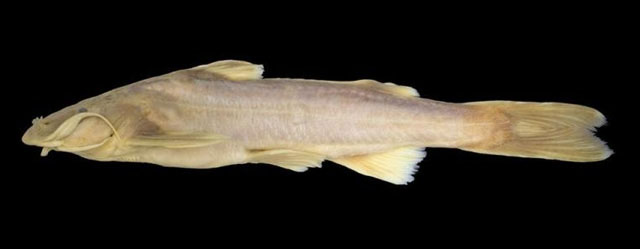| Sisoridae (Sisorid catfishes), subfamily: Sisorinae |
| 10 cm SL (male/unsexed) |
|
benthopelagic; freshwater |
| South East Asia. Indonesia. Known from the Alas River drainage in northern Sumatra, which drains the eastern face of the Leuser Mountain Range and the western face of the Central Gajo Mountain Range, debouching into the Indian Ocean (Ref. 80807). |
|
Glyptothorax ketambe can be distinguished from all other Sundaic congeners except G.
schmidti and G. siamensis in having a color pattern consisting of a dark brown body with yellowish midlateral and mid-dorsal stripes. It differs from G. schmidti in having a deeper caudal peduncle (7.6–8.9% SL vs. 5.8–7.3) and a less posteriorly-extended thoracic adhesive apparatus (not reaching vs. reaching to the level ofthe base of the last pectoral-fin ray) and from G. siamensis in having a narrower head (16.1–17.9% SL vs. 17.2–20.1) and an almost straight (vs. noticeably curved) lateral margin of the thoracic adhesive apparatus. There are eight other congeners from mainland Southeast Asia that share a similar color pattern of a
dark-colored body (with or without distinct pale midlateral and mid-dorsal stripes) with G. ketambe: G. coracinus, G. interspinalus, G. laosensis, G. longicauda, G. longjiangensis, G. strabonis, G. trilineatus and G.
zanaensis. Glyptothorax ketambe is distinguished from G. coracinus in having a wider interorbital distance (29.0–31.2% HL vs. 26.2–26.7), from G. interspinalus in having a deeper caudal peduncle (7.6–8.9% SL vs.
6.1–8.0) and a narrower head (16.1–17.9% SL vs. 17.2–22.1), from G. laosensis in having a narrower head (16.1–17.9% SL vs. 19.2–21.1) and a less posteriorly-extended thoracic adhesive apparatus (not reaching vs. reaching beyond the level of the base of the last pectoral-fin ray), and from G. longicauda in having a shorter
caudal peduncle (20.1–22.9% SL vs. 23.6) and fewer vertebrae (37–38 vs. 42). It differs from G. longjiangensis in having tubercles on the dorsal surface of the head with a single, median ridge (vs. with anastomosing tubercles with multiple ridges) and without any pale markings on the nuchal plate (vs. part or all of the nuchal plate pale-colored), from G. strabonis in having a larger eye (7.5–9.6% HL vs. 6.2–6.5), interorbital distance (29.0–31.2% HL vs. 26.0–27.2) and fewer serrations on the posterior margin of the pectoral spine (9–12 vs. 14–16), from G. trilineatus in having a longer caudal peduncle (20.1–22.9% SL vs. 16.7–18.4), and from G. zainaensis in having a shorter adipose-fin base (12.0–14.5% SL vs. 14.4–18.4), and a less posteriorly-extended thoracic adhesive apparatus (not reaching to the level of the base of the last pectoralfin ray vs. reaching beyond) (Ref. 80807). |
|
|
Data deficient (DD); Date assessed: 04 June 2019 Ref. (130435)
|
| harmless |
Source and more info: www.fishbase.org. For personal, classroom, and other internal use only. Not for publication.

